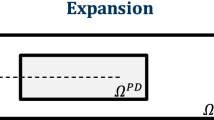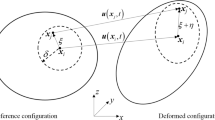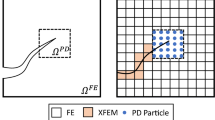Abstract
Coupling of methods based on the classical continuum mechanics (CCM), with peridynamic (PD) models is a recent hot topic in the realm of computational mechanics. In the coupled models, to optimize the usage of computational resources, usually the application of PD (the more demanding procedure) is restricted to critical areas of the domain affected by discontinuities such as propagating cracks. The remaining parts of the domain are described by a more efficient CCM-based model such as the finite element method (FEM). Here, we develop a coupled FEM/PD model for dynamic fracture modeling. The proposed method simultaneously features the following: (1) it can adaptively change the coupling configuration throughout the simulation such that only critical zones, on the verge of crack nucleation/propagation, are tackled by the PD procedure, and (2) it appropriately supports different grid spacing of PD and FEM parts. We refer to a model possessing both the features as multi-adaptive. This is crucial for a highly efficient coupling scheme. The performance of the proposed method is analyzed in terms of accuracy and computational efficiency through different numerical examples. The results show that the proposed method is superior to using a refined PD model, since it provides the same level of accuracy at a much lower computational cost. As a novel application, we present the promising results of a crack propagation problem in an unbounded domain, solved using classical artificial boundary conditions on an outer FEM layer.
























Similar content being viewed by others

References
Alhadeff A, Leon SE, Celes W, Paulino GH (2016) Massively parallel adaptive mesh refinement and coarsening for dynamic fracture simulations. Eng Comput 32(3):533–552
Ballarini R, Diana V, Biolzi L, Casolo S (2018) Bond-based peridynamic modelling of singular and nonsingular crack-tip fields. Meccanica 53(14):3495–3515
Bazazzadeh S, Mossaiby F, Shojaei A (2020) An adaptive thermo-mechanical peridynamic model for fracture analysis in ceramics. Eng Fract Mech 223:106708
Bazazzadeh S, Morandini M, Zaccariotto M, Galvanetto U (2021) Simulation of chemo-thermo-mechanical problems in cement-based materials with peridynamics. Meccanica 56(9):2357–2379. https://doi.org/10.1007/s11012-021-01375-7
Behzadinasab M, Foster JT (2019) The third sandia fracture challenge: peridynamic blind prediction of ductile fracture characterization in additively manufactured metal. Int J Fract 218(1–2):97–109
Belinha J, Azevedo J, Dinis LMDJS, Jorge RN (2018) Simulating fracture propagation in brittle materials using a meshless approach. Eng Comput 34(3):503–522
Bie Y, Cui X, Li Z (2018) A coupling approach of state-based peridynamics with node-based smoothed finite element method. Comput Methods Appl Mech Eng 331:675–700
Bobaru F, Zhang G (2015) Why do cracks branch? A peridynamic investigation of dynamic brittle fracture. Int J Fract 196(1–2):59–98
Bobaru F, Yang M, Alves LF, Silling SA, Askari E, Xu J (2009) Convergence, adaptive refinement, and scaling in 1D peridynamics. Int J Numer Meth Eng 77(6):852–877
Bobaru F, Foster J, Geubelle P, Silling S (2016) Handbook of peridynamic modeling. Advances in applied mathematics. CRC Press, Boca Raton
Boroomand B, Mossaiby F (2006) Dynamic solution of unbounded domains using finite element method: discrete Green’s functions in frequency domain. Int J Numer Meth Eng 67(11):1491–1530
Boys B, Dodwell T, Hobbs M, Girolami M (2021) PeriPy—a high performance OpenCL peridynamics package. Comput Methods Appl Mech Eng 386:114085
Brothers MD, Foster JT, Millwater HR (2014) A comparison of different methods for calculating tangent-stiffness matrices in a massively parallel computational peridynamics code. Comput Methods Appl Mech Eng 279:247–267
Diana V, Carvelli V (2020) An electromechanical micropolar peridynamic model. Comput Methods Appl Mech Eng 365:112998
Diana V, Carvelli V (2021) A continuum-molecular model for anisotropic electrically conductive materials. Int J Mech Sci 211:106759. https://doi.org/10.1016/j.ijmecsci.2021.106759
Diehl P, Jha P.K., Kaiser H, Lipton R, Levesque M (2018) Implementation of Peridynamics utilizing HPX—the C++ standard library for parallelism and concurrency. arXiv pp. arXiv–1806
Diehl P, Prudhomme S, Lévesque M (2019) A review of benchmark experiments for the validation of peridynamics models. J Peridynam Nonlocal Model 1(1):14–35
Dipasquale D, Zaccariotto M, Galvanetto U (2014) Crack propagation with adaptive grid refinement in 2D peridynamics. Int J Fract 190(1–2):1–22
Dipasquale D, Sarego G, Zaccariotto M, Galvanetto U (2016) Dependence of crack paths on the orientation of regular 2D peridynamic grids. Eng Fract Mech 160:248–263
Dipasquale D, Sarego G, Prapamonthon P, Yooyen S, Shojaei A (2022) A stress tensor-based failure criterion for ordinary state-based peridynamic models. J Appl Comput Mech 8:617–628
Diyaroglu C, Oterkus E, Oterkus S, Madenci E (2015) Peridynamics for bending of beams and plates with transverse shear deformation. Int J Solids Struct 69:152–168
Du Q, Han H, Zhang J, Zheng C (2018) Numerical solution of a two-dimensional nonlocal wave equation on unbounded domains. SIAM J Sci Comput 40(3):A1430–A1445
Elices M, Guinea G, Gomez J, Planas J (2002) The cohesive zone model: advantages, limitations and challenges. Eng Fract Mech 69(2):137–163
Engquist B, Majda A (1977) Absorbing boundary conditions for numerical simulation of waves. Proc Natl Acad Sci 74(5):1765–1766
Fan H, Li S (2017) Parallel peridynamics-SPH simulation of explosion induced soil fragmentation by using OpenMP. Comput Particle Mech 4(2):199–211
Galvanetto U, Mudric T, Shojaei A, Zaccariotto M (2016) An effective way to couple FEM meshes and Peridynamics grids for the solution of static equilibrium problems. Mech Res Commun 76:41–47
Gao W, Chen X, Wang X, Hu C (2020) Novel strength reduction numerical method to analyse the stability of a fractured rock slope from mesoscale failure. Eng Comput:1–17
Gu X, Zhang Q, Xia X (2017) Voronoi-based peridynamics and cracking analysis with adaptive refinement. Int J Numer Meth Eng 112(13):2087–2109
Ha YD, Bobaru F (2010) Studies of dynamic crack propagation and crack branching with peridynamics. Int J Fract 162(1–2):229–244
Han F, Lubineau G, Azdoud Y, Askari A (2016) A morphing approach to couple state-based peridynamics with classical continuum mechanics. Comput Methods Appl Mech Eng 301:336–358
Hermann A, Shojaei A, Steglich D, Höche D, Zeller-Plumhoff B, Cyron CJ (2022) Combining peridynamic and finite element simulations to capture the corrosion of degradable bone implants and to predict their residual strength. Int J Mech Sci 220:107143
Higdon RL (1991) Absorbing boundary conditions for elastic waves. Geophysics 56(2):231–241
Lages EN, Paulino GH, Menezes IF, Silva RR (1999) Nonlinear finite element analysis using an object-oriented philosophy-application to beam elements and to the cosserat continuum. Eng Comput 15(1):73–89
Le Q, Bobaru F (2018) Surface corrections for peridynamic models in elasticity and fracture. Comput Mech 61(4):499–518
Lubineau G, Azdoud Y, Han F, Rey C, Askari A (2012) A morphing strategy to couple non-local to local continuum mechanics. J Mech Phys Solids 60(6):1088–1102
Madenci E, Dorduncu M, Barut A, Phan N (2018) Weak form of peridynamics for nonlocal essential and natural boundary conditions. Comput Methods Appl Mech Eng 337:598–631
Mattesi V, Darbas M, Geuzaine C (2019) A high-order absorbing boundary condition for 2D time-harmonic elastodynamic scattering problems. Comput Math Appl 77(6):1703–1721
Mossaiby F, Shojaei A, Zaccariotto M, Galvanetto U (2017) OpenCL implementation of a high performance 3D Peridynamic model on graphics accelerators. Comput Math Appl 74(8):1856–1870
Mossaiby F, Shojaei A, Boroomand B, Zaccariotto M, Galvanetto U (2020) Local dirichlet-type absorbing boundary conditions for transient elastic wave propagation problems. Comput Methods Appl Mech Eng 362:112856
Ni T, Zaccariotto M, Zhu QZ, Galvanetto U (2019) Static solution of crack propagation problems in peridynamics. Comput Methods Appl Mech Eng 346:126–151
Ongaro G, Seleson P, Galvanetto U, Ni T, Zaccariotto M (2021) Overall equilibrium in the coupling of peridynamics and classical continuum mechanics. Comput Methods Appl Mech Eng 381:113515. https://doi.org/10.1016/j.cma.2020.113515
Ozdemir M, Oterkus S, Oterkus E, Amin I, Nguyen CT, Tanaka S, El-Aassar A, Shawky H (2021) Evaluation of dynamic behaviour of porous media including micro-cracks by ordinary state-based peridynamics. Eng Comput. https://doi.org/10.1007/s00366-021-01506-4
Rabczuk T, Belytschko T (2004) Cracking particles: a simplified meshfree method for arbitrary evolving cracks. Int J Numer Meth Eng 61(13):2316–2343
Rabczuk T, Belytschko T (2007) A three-dimensional large deformation meshfree method for arbitrary evolving cracks. Comput Methods Appl Mech Eng 196(29–30):2777–2799
Rabczuk T, Zi G, Bordas S, Nguyen-Xuan H (2010) A simple and robust three-dimensional cracking-particle method without enrichment. Comput Methods Appl Mech Eng 199(37–40):2437–2455
Ren H, Zhuang X, Cai Y, Rabczuk T (2016) Dual-horizon peridynamics. Int J Numer Meth Eng 108(12):1451–1476
Ren H, Zhuang X, Rabczuk T (2017) Dual-horizon peridynamics: a stable solution to varying horizons. Comput Methods Appl Mech Eng 318:762–782
Ren H, Zhuang X, Rabczuk T (2020) Nonlocal operator method with numerical integration for gradient solid. Comput Struct 233:106235
Roy P, Pathrikar A, Deepu S, Roy D (2017) Peridynamics damage model through phase field theory. Int J Mech Sci 128:181–193
Seleson P, Beneddine S, Prudhomme S (2013) A force-based coupling scheme for peridynamics and classical elasticity. Comput Mater Sci 66:34–49
Shojaei A, Hermann A, Seleson P, Cyron CJ (2020) Dirichlet absorbing boundary conditions for classical and peridynamic diffusion-type models. Comput Mech 66(4):773–793
Shojaei A, Mudric T, Zaccariotto M, Galvanetto U (2016) A coupled meshless finite point/Peridynamic method for 2D dynamic fracture analysis. Int J Mech Sci 119:419–431
Shojaei A, Zaccariotto M, Galvanetto U (2017) Coupling of 2D discretized Peridynamics with a meshless method based on classical elasticity using switching of nodal behaviour. Eng Comput
Shojaei A, Mossaiby F, Zaccariotto M, Galvanetto U (2018) An adaptive multi-grid peridynamic method for dynamic fracture analysis. Int J Mech Sci 144:600–617
Shojaei A, Galvanetto U, Rabczuk T, Jenabi A, Zaccariotto M (2019) A generalized finite difference method based on the peridynamic differential operator for the solution of problems in bounded and unbounded domains. Comput Methods Appl Mech Eng 343:100–126
Shojaei A, Mossaiby F, Zaccariotto M, Galvanetto U (2019) A local collocation method to construct dirichlet-type absorbing boundary conditions for transient scalar wave propagation problems. Comput Methods Appl Mech Eng 356:629–651
Shojaei A, Hermann A, Cyron CJ, Seleson P, Silling SA (2022) A hybrid meshfree discretization to improve the numerical performance of peridynamic models. Comput Methods Appl Mech Eng 391:114544
Silling SA (2000) Reformulation of elasticity theory for discontinuities and long-range forces. J Mech Phys Solids 48(1):175–209
Silling SA, Askari E (2005) A meshfree method based on the peridynamic model of solid mechanics. Comput Struct 83(17–18):1526–1535
Silling SA, Epton M, Weckner O, Xu J, Askari E (2007) Peridynamic states and constitutive modeling. J Elast 88(2):151–184
Silling S, Littlewood D, Seleson P (2015) Variable horizon in a peridynamic medium. J Mech Mater Struct 10(5):591–612
Source code for coupled FEM-PD solver, https://doi.org/10.6084/m9.figshare.19187735
Sukumar N, Moës N, Moran B, Belytschko T (2000) Extended finite element method for three-dimensional crack modelling. Int J Numer Meth Eng 48(11):1549–1570
Sun W, Fish J (2019) Superposition-based coupling of peridynamics and finite element method. Comput Mech 64(1):231–248
Wang L, Chen Y, Xu J, Wang J (2017) Transmitting boundary conditions for 1D peridynamics. Int J Numer Meth Eng 110(4):379–400
Wang X, Kulkarni SS, Tabarraei A (2019) Concurrent coupling of peridynamics and classical elasticity for elastodynamic problems. Comput Methods Appl Mech Eng 344:251–275
Wang Y, Zhou X, Zhang T (2019) Size effect of thermal shock crack patterns in ceramics: insights from a nonlocal numerical approach. Mech Mater 137:103133
Weckner O, Abeyaratne R (2005) The effect of long-range forces on the dynamics of a bar. J Mech Phys Solids 53(3):705–728
Wildman RA, Gazonas GA (2013) A perfectly matched layer for peridynamics in two dimensions. J Mech Mater Struct 7(8):765–781
Wildman RA, Gazonas GA (2014) A finite difference-augmented peridynamics method for reducing wave dispersion. Int J Fract 190(1–2):39–52
Yu Y, Bargos FF, You H, Parks ML, Bittencourt ML, Karniadakis GE (2018) A partitioned coupling framework for peridynamics and classical theory: analysis and simulations. Comput Methods Appl Mech Eng 340:905–931
Yu K, Xin X, Lease KB (2010) A new method of adaptive integration with error control for bond-based peridynamics. In: Proceedings of the world congress on engineering and computer science, vol 2, pp 1041–1046
Zaccariotto M, Tomasi D, Galvanetto U (2017) An enhanced coupling of PD grids to FE meshes. Mech Res Commun 84:125–135
Zaccariotto M, Mudric T, Tomasi D, Shojaei A, Galvanetto U (2018) Coupling of FEM meshes with Peridynamic grids. Comput Methods Appl Mech Eng 330:471–497
Zaccariotto M, Shojaei A, Galvanetto U (2021) Chapter 6—coupling of CCM and PD in a meshless way. In: Oterkus E, Oterkus S, Madenci E (eds) Peridynamic modeling, numerical techniques, and applications. Elsevier series in mechanics of advanced materials, Elsevier, pp 113–138. https://doi.org/10.1016/B978-0-12-820069-8.00014-7
Zhang W, Yang J, Zhang J, Du Q (2017) Artificial boundary conditions for nonlocal heat equations on unbounded domain. Commun Comput Phys 21(1):16–39
Zhang J, Yu T, Bui TQ (2021) An adaptive XIGA with locally refined NURBS for modeling cracked composite FG Mindlin-Reissner plates. Eng Comput. https://doi.org/10.1007/s00366-021-01334-6
Acknowledgements
Funded by the Deutsche Forschungsgemeinschaft (DFG, German Research Foundation)-470246804.
Author information
Authors and Affiliations
Corresponding author
Ethics declarations
Conflict of interest
The authors declare that they have no conflict of interest to disclose.
Additional information
Publisher's Note
Springer Nature remains neutral with regard to jurisdictional claims in published maps and institutional affiliations.
Rights and permissions
About this article
Cite this article
Mossaiby, F., Sheikhbahaei, P. & Shojaei, A. Multi-adaptive coupling of finite element meshes with peridynamic grids: robust implementation and potential applications. Engineering with Computers 39, 2807–2828 (2023). https://doi.org/10.1007/s00366-022-01656-z
Received:
Accepted:
Published:
Issue Date:
DOI: https://doi.org/10.1007/s00366-022-01656-z



